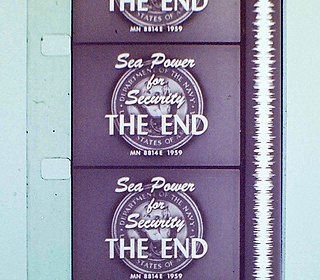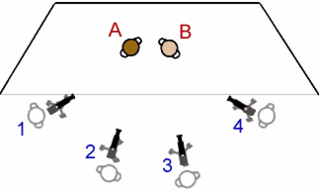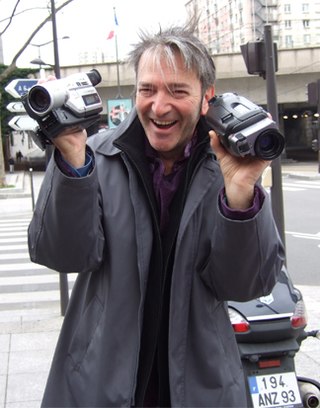
16 mm film is a historically popular and economical gauge of film. 16 mm refers to the width of the film ; other common film gauges include 8 mm and 35 mm. It is generally used for non-theatrical film-making, or for low-budget motion pictures. It also existed as a popular amateur or home movie-making format for several decades, alongside 8 mm film and later Super 8 film. Eastman Kodak released the first 16 mm "outfit" in 1923, consisting of a camera, projector, tripod, screen and splicer, for US$335. RCA-Victor introduced a 16 mm sound movie projector in 1932, and developed an optical sound-on-film 16 mm camera, released in 1935.
Regular television broadcasts in the United Kingdom started in 1936 as a public service which was free of advertising, which followed the first demonstration of a transmitted moving image in 1926. Currently, the United Kingdom has a collection of free-to-air, free-to-view and subscription services over a variety of distribution media, through which there are over 480 channels for consumers as well as on-demand content. There are six main channel owners who are responsible for most material viewed.
WNET, branded on-air as "Thirteen", is a primary PBS member television station licensed to Newark, New Jersey, United States, serving the New York City area. Owned by The WNET Group, it is a sister station to the area's secondary PBS member, Garden City, New York–licensed WLIW, and two class A stations: WMBQ-CD, and WNDT-CD. The WNET Group also operates New Jersey's PBS state network NJ PBS, and the website NJ Spotlight through an outsourcing agreement.

BBC Television is a service of the BBC. The corporation has operated a public broadcast television service in the United Kingdom, under the terms of a royal charter, since 1927. It produced television programmes from its own studios from 1932, although the start of its regular service of television broadcasts is dated to 2 November 1936.

World in Action is a British investigative current affairs programme made by Granada Television for ITV from 7 January 1963 until 7 December 1998. Its campaigning journalism frequently had a major impact on events of the day. Its production teams often took audacious risks, and the programme gained a solid reputation for its often-unorthodox approach. The series was sold around the world and won numerous awards. In its heyday, World in Action drew audiences of up to 23 million in Britain alone, equivalent to almost half the population.
The BBC Studios Natural History Unit (NHU) is a department of BBC Studios that produces television, radio and online content with a natural history or wildlife theme. It is best known for its highly regarded nature documentaries, including The Blue Planet and Planet Earth, and has a long association with David Attenborough's authored documentaries, starting with 1979's Life on Earth.

Visual anthropology is a subfield of social anthropology that is concerned, in part, with the study and production of ethnographic photography, film and, since the mid-1990s, new media. More recently it has been used by historians of science and visual culture. Although sometimes wrongly conflated with ethnographic film, visual anthropology encompasses much more, including the anthropological study of all visual representations such as dance and other kinds of performance, museums and archiving, all visual arts, and the production and reception of mass media. Histories and analyses of representations from many cultures are part of visual anthropology: research topics include sandpaintings, tattoos, sculptures and reliefs, cave paintings, scrimshaw, jewelry, hieroglyphics, paintings and photographs. Also within the province of the subfield are studies of human vision, properties of media, the relationship of visual form and function, and applied, collaborative uses of visual representations.

Electronic news gathering (ENG) or electronic journalism (EJ) is usage of electronic video and audio technologies by reporters to gather and present news instead of using film cameras. The term was coined during the rise of videotape technology in the 1970s. ENG can involve anything from a single reporter with a single professional video camera, to an entire television crew taking a truck on location.

Videography is the process of capturing moving images on electronic media and even streaming media. The term includes methods of video production and post-production. It used to be considered the video equivalent of cinematography, but the advent of digital video recording in the late 20th century blurred the distinction between the two, as in both methods the intermediary mechanism became the same. Nowadays, any video work could be called videography, whereas commercial motion picture production would be called cinematography.
Together TV is a British free-to-air television channel owned by The Community Channel, a community benefit society. The channel targets a women's audience aged 40 to 60, with programming related to health and wellness, hobbies, and creativity.

The Revolution Will Not Be Televised, also known as Chávez: Inside the Coup, is a 2003 Irish documentary film. It focuses on events in Venezuela leading up to and during the April 2002 coup d'état attempt, which saw President Hugo Chávez removed from office for two days. With particular emphasis on the role played by Venezuela's private media, the film examines several key incidents: the protest march and subsequent violence that provided the impetus for Chávez's ousting; the opposition's formation of an interim government headed by business leader Pedro Carmona; and the Carmona administration's collapse, which paved the way for Chávez's return. The Revolution Will Not Be Televised was directed by Irish filmmakers Kim Bartley and Donnacha Ó Briain. Given direct access to Chávez, the filmmakers intended to make a fly-on-the-wall biography of the president. They spent seven months filming in Venezuela, following Chávez and his staff and interviewing ordinary citizens. As the coup unfolded on 11 April, Bartley and Ó Briain filmed on the streets of the capital, Caracas, capturing footage of protesters and the erupting violence. Later, they filmed many of the political upheavals inside Miraflores, the presidential palace.

Outside broadcasting (OB) is the electronic field production (EFP) of television or radio programmes from a mobile remote broadcast television studio. Professional video camera and microphone signals come into the production truck for processing, recording and possibly transmission.

The multiple-camera setup, multiple-camera mode of production, multi-camera or simply multicam is a method of filmmaking and video production. Several cameras—either film or professional video cameras—are employed on the set and simultaneously record or broadcast a scene. It is often contrasted with a single-camera setup, which uses one camera.

The All-Russia State Television and Radio Broadcasting Company or Russian Television and Radio Broadcasting Company, also known as Russian Television and Radio, is a national state-owned broadcaster which operates many television and radio channels in 53 of Russia's languages. The company was founded in 1990 and is based in Moscow.
The British Broadcasting Corporation (BBC) is a British public service broadcaster headquartered at Broadcasting House in London, England. Originally established in 1922 as the British Broadcasting Company, it evolved into its current state with its current name on New Year's Day 1927. The oldest and largest local and global broadcaster by stature and by number of employees, the BBC employs over 21,000 staff in total, of whom approximately 17,900 are in public-sector broadcasting.

A television show, TV program, or simply a TV show, is the general reference to any content produced for viewing on a television set that is broadcast via over-the-air, satellite, or cable. This includes content made by television broadcasters and content made for broadcasting by film production companies. It excludes breaking news, advertisements, or trailers that are typically placed between shows. Television shows are most often scheduled for broadcast well ahead of time and appear on electronic guides or other TV listings, but streaming services often make them available for viewing anytime. The content in a television show is produced by one of two production methodologies: live taped shows such as variety and news magazine shows shot on a television studio stage or sporting events The other production model includes animation and a variety of film productions ranging from movies to series. Shows not produced on a television studio stage are usually contracted or licensed to be made by appropriate production companies.
Ivan Polunin (1920–2010) was a medical doctor, author, teacher, documentary filmmaker, and photographer. He is best known for his rare colour films, which document cultural traditions and wildlife in Singapore and Malaysia from the 1950s. The films contain important historical and sociological information, and were recently the subject of a local documentaries Lost Images and "Invisible City" which showed his well-preserved film archive. His work has been featured in National Geographic magazine; aired on the BBC and stored in the Smithsonian.

Jean-Claude Mocik, was born on February 9, 1958, in Livry Gargan. He is a filmmaker, video director, a director and teacher.

ABS-CBN HD was a Philippine pay television channel, working as the high-definition feed of ABS-CBN. It was launched on October 3, 2015 initially on Sky Cable and Destiny Cable and later on iWant, Sky On Demand, and Sky Direct, broadcasting in 1080i at a frame rate of 50 fps or at 60fps. The network including its HD feed dissolved on May 5, 2020 at 7:52 pm following TV Patrol. It was replaced by Kapamilya Channel HD on June 13, 2020.


















